In Part 1 I detailed my climate formula and the ranking of U.S. metropolitan areas. In this post I want to explore the rankings in more detail, highlighting some interesting aspects.
Classification
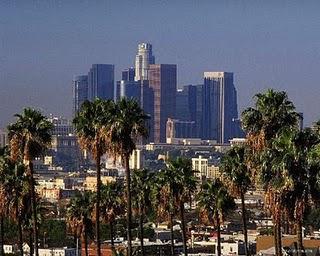
Los Angeles has a "perfect" Mediterranean climate (Koppen)
My rankings make no reference to existing climate classification systems, such as those by Koppen and Thornthwaite. This is intentional. These standard systems are designed to classify global climates, identifying very large areas by temperature, precipitation, flora and fauna, prevailing winds, etc. This is absolutely legitimate, and I really like the Koppen regime that provides major climate groups (tropical, temperate, polar, etc.) and various sub-groups based on annual precipitation, temperature ranges, and seasonality (among other characteristics).However, there are two major reasons I chose a different approach. First, I'm interested in where it would be most comfortable to live and/or spend a lot of time, which I think is primarily based on temperature and not other climate characteristics such as precipitation. All aspects of climate matter deeply in the various Earth sciences and maybe even economics, but not necessarily in livability. Second, because these systems are global in scale, they group vast areas together with insufficient differentiation. According to Koppen, Baltimore (my hometown) falls under the Humid subtropical classification, but so does Brownsville, Texas. As my rankings show, Baltimore and Brownsville experience very different climates (mean January temp.: 37 degrees and 60 degrees, respectively). For practicality, we need a system that is more specific.
Humidity and Precipitation
I touched on this above and I discussed it briefly in Part 1. However, I received a couple of comments from readers who felt that humidity and precipitation should be more of a factor (or a factor) in the climate rankings. Again, my position is that at the extremes, such as high humidity coupled with high temperature or extremely low annual precipitation, these climate characteristics can certainly be important. That concession aside, in general, in the United States, the benefits of indoor climate control (both in buildings and in vehicles), extensive irrigation and landscaping in dry areas, and seasonal variations in humidity and precipitation patterns, all work to mitigate the discomfort of high or low humidity and/or precipitation. As Celeste from North Dakota commented to Part 1, "...back to the issues of heat and humidity...I would go for these places [San Diego or Jacksonville] - humidity or not - before choosing a place like Minot [North Dakota] where I could literally freeze to death 8 months of the year."
Patterns - The Coastal Effect
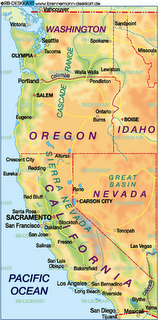
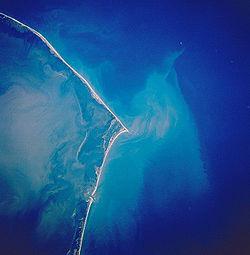
The Outer Banks
The pattern is the same on the East Coast, but the temperatures (both mean and variance) are more extreme - as is the weather in general (the Atlantic and Gulf coasts are subject to hurricane strikes every summer and autumn). Perhaps the most interesting location is the Outer Banks of North Carolina. For instance, Hatteras Island (climate score 21.6) has a significantly higher climate score than places immediately to the west on the mainland coast like Jacksonville, NC (16.8) and Elizabeth City, NC (15.8), and as high as locations much farther to the southeast like Savannah, Georgia (21.8) or "hot" places like Tucson, Arizona (22.0).Patterns - The Elevation Effect
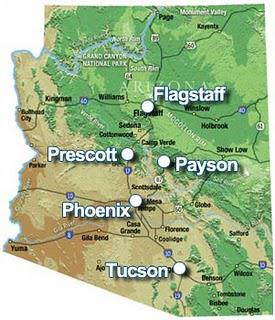
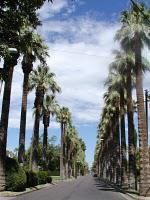
Palm-lined street in Phoenix
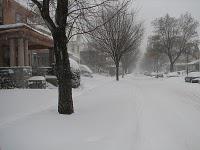
Snow in Prescott
Meanwhile, just 100 miles to the north of Phoenix is Prescott (the original capital of Arizona Territory), which sits at 5,400 feet above sea level. There it's cold in the winter (see the snowy picture to the right) and mild in the summer, mild for Arizona anyway. The annual mean temperature is 54 degrees, 20 degrees lower than Phoenix. Just 100 miles, but 4,200 feet of elevation, results in substantially different climates. Another 50 miles north and 1,400 feet higher in elevation is Flagstaff where there is a genuinely cold climate. The annual mean temperature is just 46 degrees. In few places in the United States will you find such distinctly different climates in such a short distance, emphatically underscoring the relationship between elevation and temperature.Florida and California
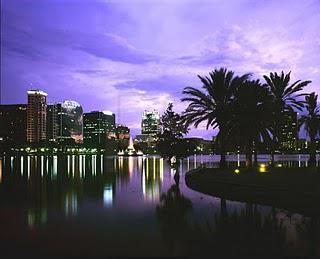
Orlando at night
The two continental states that enjoy the best climates are clearly Florida and California. Together they occupy 19 of the top 23 places in the rankings, including 12 of the top 13 (Honolulu, little surprise, gets the top spot). First, it's important to note that both states have a lot of people - think this somewhat attributable to their climates? - which means that they both have a lot of metropolitan areas. If Hawaii was bigger with more people, it would dominate the top of the rankings. But accepting that, these states have great climates because they benefit from geography.Florida is located farther south than any other state, but larger portions of Texas are just as far south as most of the Florida peninsula. However, Texas does not enjoy the moderating benefit of two warm bodies of water acting as "blockers" preventing cold air from penetrating the Florida peninsula during winter. The Gulf of Mexico and Atlantic Ocean also keep Florida's temperature somewhat moderated in summer. Cold snaps are possible, especially in north and central Florida, and summer is hot and humid, but all-in-all, Florida greatly benefits from being surrounded by water. Want more proof, consider the climate of Fuzhou, China, which is located at about the same latitude as Miami in southeast China. It's much cooler than Miami though because cold continental weather, not moderated by warm water, affects the area during winter.
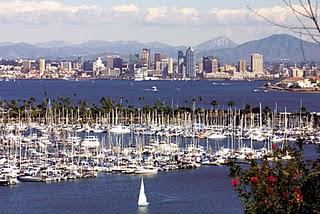
San Diego harbor
California has other advantages. The lowing lying coastal areas are (1) protected from cold continental air by high mountains to the north and east, and (2) benefit from the cool Pacific which moderates year-round temperatures. The results is lots of sun and comparatively moderate temperatures all year long. The Central Valley gets lots of sunshine and being removed from the Pacific it sees higher summer temperatures and lower winter temperatures than the coast, but also benefits from the high mountains along the eastern border of the state, which help to deflect cold continental air. The net result is a really pleasant climate in most of the heavily populated areas.Unexpected Results
As I compiled these rankings, I was surprised by the result for two major cities, Phoenix and Las Vegas. The impression I had of Phoenix was that it was a great climate, sure it is hot in summer but that's why there is air conditioning. After all, lots of people seem to retire to the greater Phoenix area, which for decades was one of the fastest growing big cities in America. However, I think this is something of an illusion. Phoenix is mild in winter, with highs in the 60s and 70s and lows in the 40s. But in the summer it is just too hot. From June 1st through September 14, the mean high temperature is at least 100 degrees, and June through August the mean temperature is over 90 degrees. That's just unbearable, and I say that as a person who likes heat. It must be impossible to spend time outdoors in the summer sun. As a result, Phoenix's climate score is "just" 21.0, ranking 11th out of the 30 largest metropolitan areas in the United States. Phoenix's climate is more like that of Riyadh and Baghdad than Los Angeles.
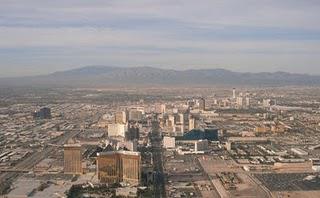
The arid Las Vegas valley
Now Las Vegas gains its reputation as an adult playground for reasons largely separate from the climate. However, the fancy resort/casino pools and palm-lined streets would give the impression of a fine climate. This really isn't the case. I've been to Las Vegas twice, the first time was Labor Day weekend 2007. The temperature was meltingly hot, with highs way over 100. I couldn't walk along the Las Vegas Strip for long. The second trip was in late April 2009, and I arrived to mid-day temperatures in the 50s (it did warm up over the next couple of days though). These experiences highlight the fact that Las Vegas is colder in the winter and hotter in the summer than may be commonly believed. Winter lows are in the mid-30s, and I bet it would receive more snow if it wasn't located in one of the driest parts of the country. The city's climate score is only 13.0 (that's not much better than Baltimore - 9.9), and ranks just 16th out of the 30 largest metropolitan areas in the United States.Rankings at the Extremes
In developing these rankings I surveyed all major cities as well as some smaller places at geographically interesting locations to get a sense of the climate at elevation, latitude, and other extremes.
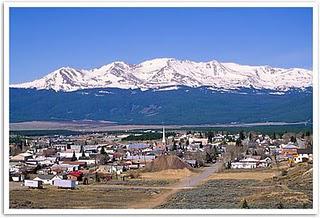
Leadville at over 10,000 feet elevation
Leadville, Colorado is located southwest of Denver, but at an elevation of over 10,000 feet; one of the highest towns in the U.S. As a result the weather is cold, and the climate score is a bone-chilling -20.0, practically the same as Fargo, North Dakota.
Badwater Basin - the lowest, hottest spot in North America
Conversely, Death Valley, California is the lowest spot in North America. Badwater Basin is situated 282 feet below sea level. Death Valley is the hottest place in North America and one of the hottest places on Earth. The July mean high temperature is deadly 115 degrees, and July mean temperature is over 100 degrees! It's climate score is 12.3, which is probably generous (I didn't account for super-extremes like this).
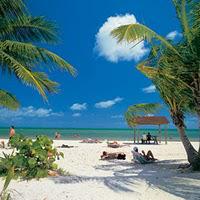
Idyllic Key West
Key West, Florida is located farther south than any other city in continental U.S. It also has the best climate. The mean January low is 65 degrees and mean August high is 90 degrees. Idyllic. The climate score is 47.3, nearly as high as Honolulu (48.3).
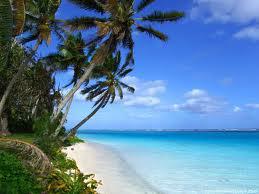
Hilo - the highest rated climate in the U.S.
Hilo, Hawaii is the largest city on the Big Island. It has the sunny distinction of having the highest climate score of any city that I surveyed at 53.2. It's like an even less variable version of Key West. Because of it's location, I would also suggest that it's one of the least visited cities on my rankings.Barrow, Alaska on the other hand has the gloomy distinction of having the lowest climate score (by far) of any city that I surveyed at -48.8. It surely looks forlorn (see the picture). In February, the mean temperature drops to -16 degrees. It's somewhat hard to believe that the record low is "just" -56 degrees. Imagine spending the dark polar night in Barrow for the winter...what a horror.
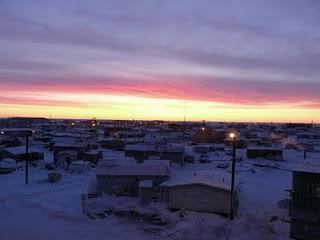
Barrow during the winter twilight - the worst climate in the U.S.
The East is not without it's cold areas. Upstate Maine is thinly populated and probably even less thought about. But cities like Caribou and Jackman have climates just as extreme as Fargo and Grand Forks, and in great contrast to coastal cities like Portland.
---
I'll return to theme of climate in the future, discussing other parts of the globe. Until then, look for a new climate page that will include much of the data cited in these two posts.
Having trouble submitting comments, or are your comments not displayed after you submit them? If so, please email any comments or thoughts to [email protected].

